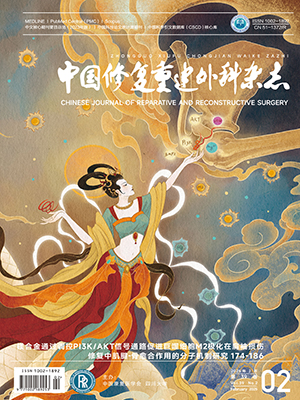Objective To investigate the effect of canine decellularized tendon slices (DTSs) on tendon-bone healing in repairing rotator cuff injury of rabbit. Methods Canine DTSs were prepared by repetitive freeze/thaw 5 times combined with nuclease processing for 12 hours from the adult Beagles Achilles tendons. Histological observation and cytocompatibility evaluation for the canine DTSs were performed in vitro. Twenty-four mature male New Zealand white rabbits, weighing 2.5-3.0 kg, were randomly selected. U-shaped defect of more than 50% of normal tendon in width and 8 mm in length was made in infraspinatus tendons of unilateral limb as the experimental group; the canine DTSs were used to repair defect, and the insertion of infraspinatus tendon on greater tuberosity of humerus was reconstructed in the experimental group. No treatment was done on the contralateral limb as the control group. At 4, 8, and 12 weeks after operation, the specimens were harvested for histological observation and biomechanical test. Results Histological examination showed that collagen fibers of canine DTSs were well preserved, without residual cells. The cytocompatibility examination showed that fibroblasts attached well to canine DTSs. Biomechanical test showed that the maximum load and stiffness increased significantly with time, and the maximum load and stiffness at 12 weeks were significantly higher than those at 4 and 8 weeks (P lt; 0.05). The maximum load and stiffness of the experimental group at 4 and 8 weeks were significantly lower than those of the control group (P lt; 0.05). The stiffness of the experimental group at 12 weeks was significantly lower than that of the control group (t= — 5.679, P=0.000), but no significant difference was found in the maximum load at 12 weeks between 2 groups (t=0.969, P=0.361). Histological observation showed that the control group displayed a 4-layer structure of the tendon-bone insertion. In the experimental group at 4 weeks, the tendon-bone interface was filled with granulation tissue, and a small amount of Sharpey’s fibers-like connected the tendon to bone; granulation tissue disappeared, and fibroblasts, Sharpey’s fiber, new cartilage, and chondrocytes significantly increased with time; tendon-bone interface became mature, but the tide line was not observed between the unmineralized fibrocartilage and mineralized fibrocartilage. Conclusion Canine DTSs prepared by repetitive freeze/thaw 5 times combined with nuclease processing for 12 hours, can enhance the healing of host tendon-bone and improve the biomechanical characteristics of the rabbit infraspinatus tendon.
Citation: PAN Juan,LIU Guoming,NING Liangju,LUO Jingcong,HUANG Fuguo,QIN Tingwu. ROTATOR CUFF REPAIR WITH DECELLULARIZED TENDON SLICES FOR ENHANCING TENDON-BONE HEALING IN RABBITS. Chinese Journal of Reparative and Reconstructive Surgery, 2013, 27(9): 1070-1075. doi: 10.7507/1002-1892.20130234 Copy
Copyright © the editorial department of Chinese Journal of Reparative and Reconstructive Surgery of West China Medical Publisher. All rights reserved




